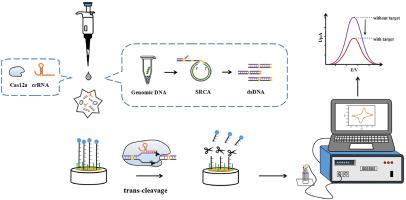Talanta ( IF 5.6 ) Pub Date : 2022-08-09 , DOI: 10.1016/j.talanta.2022.123821 Luqi Huang 1 , Ning Yuan 2 , Wei Guo 1 , Yunzhe Zhang 1 , Wei Zhang 3

|
As one of the major foodborne pathogens, Staphylococcus aureus (S. aureus) can cause infectious diseases. In the current study, a novel electrochemical biosensor based on saltatory rolling circle amplification (SRCA) combined with CRISPR/Cas12a system was developed for the accurate detection of S. aureus. The thio-modified reporter probes (SH-ssDNA-MB) was immobilized on the surface of gold nanoparticle-modified electrode through the Au–S bond. In the presence of S. aureus, the target DNA double strands obtained by SRCA can be specifically recognized with Cas12a/crRNA complex. The trans-cleavage activity of Cas12a induces SH-ssDNA-MB to be cleaved from the electrode surface, resulting in a decrease in the current signal. Subsequently, the ratio of the current can be calculated as the detection result. Under optimal conditions, the detection limits were 2.51 fg/μL for genomic DNA and 3 CFU/mL for S. aureus in pure cultures, respectively. Moreover, the method demonstrated satisfactory specificity, acceptable stability and reproducibility. In comparison with ISO methods, the sensitivity, specificity and accuracy of the developed method were 100%, 97.8% and 98%, respectively. In conclusion, the developed novel electrochemical biosensor provides a potential powerful platform for the accurate detection of S. aureus.
中文翻译:

基于SRCA-CRISPR/Cas12a的高灵敏检测金黄色葡萄球菌的电化学生物传感器
金黄色葡萄球菌(S. aureus )作为主要的食源性致病菌之一,可引起传染病。在目前的研究中,开发了一种基于跳跃式滚环扩增 (SRCA) 结合 CRISPR/Cas12a 系统的新型电化学生物传感器,用于准确检测金黄色葡萄球菌。硫代修饰的报告探针 (SH-ssDNA-MB) 通过 Au-S 键固定在金纳米粒子修饰的电极表面。在金黄色葡萄球菌存在的情况下, SRCA获得的目标DNA双链可以被Cas12a/crRNA复合物特异性识别。反式-cleavage activity of Cas12a induces SH-ssDNA-MB to be cleaved from the electrode surface, resulting in a decrease in the current signal. Subsequently, the ratio of the current can be calculated as the detection result. Under optimal conditions, the detection limits were 2.51 fg/μL for genomic DNA and 3 CFU/mL for S. aureus in pure cultures, respectively. Moreover, the method demonstrated satisfactory specificity, acceptable stability and reproducibility. In comparison with ISO methods, the sensitivity, specificity and accuracy of the developed method were 100%, 97.8% and 98%, respectively. In conclusion, the developed novel electrochemical biosensor provides a potential powerful platform for the accurate detection of S. aureus.











































 京公网安备 11010802027423号
京公网安备 11010802027423号